Check out my custom vibration dampener
Babolat Pure Aero 2019
In-depth Review & Playtest
We hope you love this article. Just so you know, TennisCompanion may collect a small share of sales from the links on this page to help keep this site running. Learn more.
The Babolat Pure Aero 2019 is one of the most popular frames on the market, and our pick for one of the best tennis racquets in 2022, which improves on nearly 15 years of innovation for the Pure Aero line.
Built for the game’s modern players like Rafel Nadal, the racquet has broad appeal helping players maximize their spin and power, which makes it an excellent option and worthy contender for a wide range of players.
Of course, no tennis racquet is perfect, and what works for one player rarely translates to the next. With that in mind, I’ve pulled together this in-depth review and playtest to share my experience as a point of reference to determine if it’s a good fit for you.
Article Contents
Click below to jump to a section
Tap below to jump to a section
Video Review & Playtest
About the Pure Aero
Tech, Specs, and Players
Pure Aero Models
Review & Playtest Notes
Summary & Takeaways
New to TennisCompanion?
Create a free account and explore my latest videos below
Babolat Pure Aero 2019 Video Review & Playtest
There’s a lot to consider when evaluating a tennis racquet like the Babolat Pure Aero 2019. To help make it easier, I’ve created the following video review and playtest – sit back and enjoy.
I cover a lot of ground in the video, so below, I’ve included timestamps for the different sections for quick reference.
Intro
0:24: Intro
Specs
0:43: Spec Start
1:03: Length, Head Size, String Pattern
1:03: Weight
1:30: Balance
1:40: Stiffness
1:46: Swingweight
Technologies
2:01: Technologies Start
2:27: Aeromodular 3
2:48: Bumper Guard Note
3:06: Carbon Ply Stabilizer
3:13: Cortex Pure Feel
3:27: FSI Spin
Playtest
3:47: Playtest Start
4:08: Playtest Notes
4:30: Groundstrokes
4:52: Volleys
5:35: Serves
6:13: Returns
Wrapping Up
6:35: Strings
7:15: Who It’s For
8:00: Closing Notes
Keep reading to explore the Babolat Pure Aero 2019 in greater detail as this guide serves as a great companion to the video.
About the Babolat Pure Aero 2019
Since it’s inception in 2003 and subsequent collaboration and adoption by Rafael Nadal in 2004, the Babolat Pure Aero has become one of the most popular and best-selling tennis racquets with a loyal following.
The Pure Aero 2019 is Babolat’s 7th generation, and although it has evolved quite a bit since the original frame, it maintains some of the key ingredients that made it so popular – namely, spin and power.
The racquet gets its name from its aerodynamic frame design, allowing the racquet to swing fast to generate maximum spin.
For reference, here’s a list of all seven variations of the tennis racquet that have released roughly every 2-3 years:
- Aeropro Drive 2004
- Aeropro Drive 2007-2008
- Aeropro Drive 2010-2012
- Aeropro Drive 2013
- Aeropro Drive French Open 2014
- Pure Aero 2016
- Pure Aero 2019
Babolat’s CEO, Eric Babolat, describes the start of their now-iconic frame:
“When we understood how strong he [Nadal] would be, we decided to build a new racquet completely adapted to his game. A racket that focuses on power and spin.”
Babolat Pure Aero 2019 vs. 2016
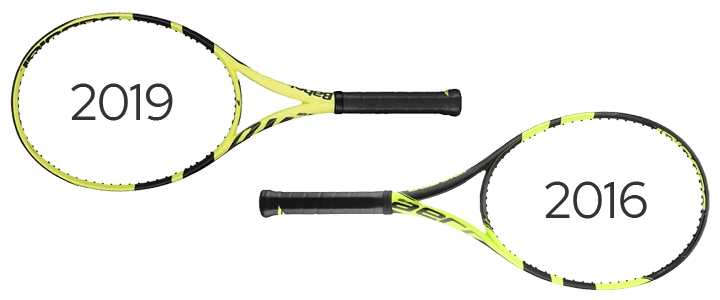
One of the big questions that often comes up for players is how the latest version of a frame differs from its predecessor.
Beyond the apparent change in the racquet’s paint job from electric lime green to the now commonly dubbed banana yellow, there have been a few minor tweaks to the racquet.
Here’s a quick snapshot of the specs that have changed:
| Pure Aero Models | 2016 | 2019 |
| Strung Weight | 11.3oz / 320.35g | 11.2oz / 318g |
| Swingweight | 327 | 324 |
| Stiffness | 69 | 67 |
On paper, the racquets haven’t changed all that much, and we can summarize the updates by saying it’s ever so slightly lighter and a bit less stiff to improve comfort and feel.
However, beyond the measurable specs, Babolat moved their Cortex Pure Feel technology from the bottom of the racquet’s shaft to the three and nine o’clock positions of the frame’s head.
Although they changed Cortex Pure Feel technology’s location, they did add new material or their Carbon Ply Stabilizer to the throat to help cut down on twisting for torsional stability.
They’ve also moved from Aeromodular 2 to 3 in the 2019 version with the update centered around a new bumper guard that does a better job of protecting the strings while also removing the short and long side string installation, which your stringer will appreciate.
Tech, Specs, and Players Endorsing the Pure Aero
Babolat integrates a handful of unique technologies into the Pure Aero’s frame, so let’s review them and the intention behind each feature.

First up, the racquets Aeromodular 3 frame design makes this line unique and one of the first things you notice when you pick up the racquet.
From the throat to the tip of the racquet’s head, you quickly get a sense for the aerodynamic considerations of the design. Down to the sleek profile of the grommets and bumper guard, which combine to help the racquet move through the air and swing fast for maximum spin.
Helpful Tip
The bumper guard’s design is a nice improvement over the previous generation, which tended to wear quickly and expose the strings.

Integrated into the frame, you’ll also find Babolat’s Woofer technology, which enhances the response of the racquet’s strings to increase the size of the sweetspot, improve power, and reduce shock.
If you’re coming from a different racquet, perhaps the most unique part of this frame’s design is the throat, which is bulkier than most and has a unique feel in hand. I wouldn’t say it’s good or bad, just different.
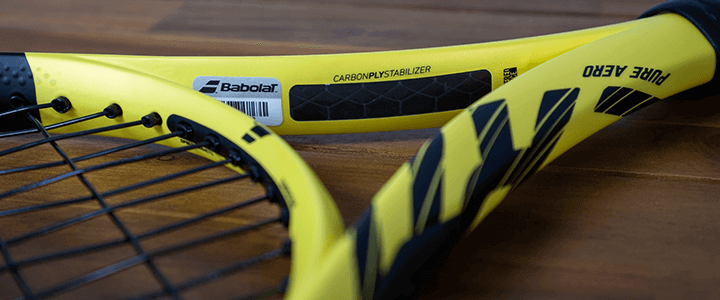
Next up, the racquet features Carbon Ply Stabilizing technology in the throat to help prevent twisting and subsequently improve control.

At the three and nine o’clock positions of the racquet’s head, you’ll also find Babolat’s Cortex Pure Feel technology integrated into the graphite to help dampen vibration and improve feel, previously located in the shaft just above the handle.
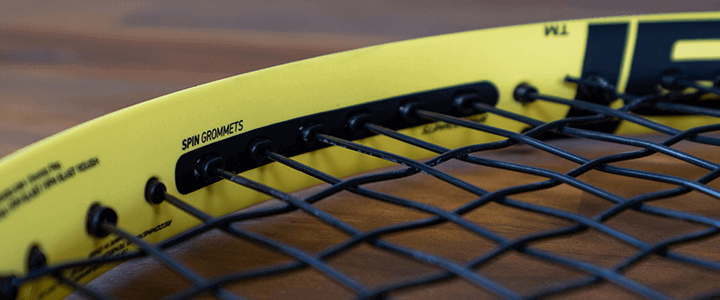
Last but not least, the Pure Aero features Babolat’s FSI Spin technology, which combines an open string pattern with oblong shaped grommets at the six and twelve o’clock positions of the head for enhancing string movement and maximizing spin.
Babolat Pure Aero Specs

Whether you’re buying a new frame or on the hunt for your first racquet, the specs can be a useful point of comparison.
Here’s a look at the specs for the Babolat Pure Aero 2019.
| Spec | Measurement |
| Head Size | 100 in² / 645.16 cm² |
| Length | 27 in / 68.58c m |
| Strung Weight | 11.2 oz / 318 g |
| Unstrung Weight | 10.6 oz / 300 g |
| Balance | 4 pts HL / 33 cm |
| Unstrung Balance | 7 pts HL / 32 cm |
| Swingweight | 324 |
| Stiffness | 67 |
| Beam Width | 23 mm / 26 mm / 23 mm |
| Composition | Graphite |
| String Pattern | 16 Mains / 19 Crosses |
| String Tension | 50-59 pounds / 23-27 kg |
The racquet has a mid-plus head size of 100 square inches that works well for a wide range of players along with a standard length of 27 inches that will be familiar to most.
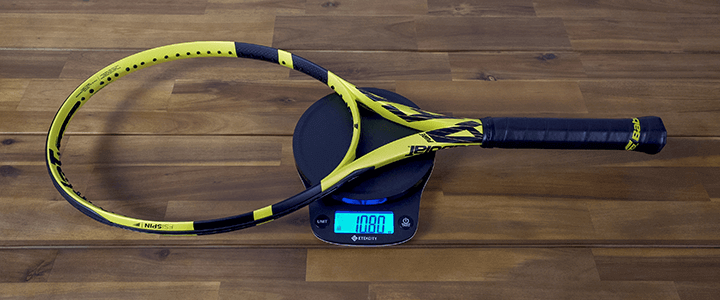
*Note: Babolat has a +/- 7 g tolerance for the Pure Aero, which means the racquet you buy may be up to 7 grams lighter or heavier.
As for its weight, 11.2 ounces is also middle of the road and quite manageable for a variety of players. Along with a balance at 4 points headlight and swingweight of 324, the racquet is maneuverable and easy enough to swing while remaining relatively stable on contact.
Lastly, the stiffness rating of 67 helps deliver power and falls in a range that may lack comfort for players who have arm injuries, especially when paired with a less comfortable polyester tennis string.
Players Endorsing
Although Rafael Nadal single-handedly made this frame one of the best-selling, he’s not the only one endorsing the racquet.
As you review the list, keep in mind that an endorsement doesn’t necessarily guarantee that your favorite player is using that exact frame.
For example, Rafa still uses the original Aeropro Drive, but it’s painted to look like the most current frame. Of course, you can’t buy new racquets of the original version, but they’re available to top players and referred to in the industry as pro stock.
Logically, it makes sense. It can take a player a while to adjust to a new tennis racquet, so unless there’s a strategic reason to change, you won’t typically find players changing frequently. Plus, some of the top pros are under contract, limiting their flexibility in some scenarios.
Furthermore, if a player uses the exact model off the shelf, there’s a high likelihood that they’ve customized their racquet to best align with their style of play and preferences. Of course, that doesn’t diminish the efficacy of the current model, but it’s good to be aware as a consumer.
With that said, here’s a list of men and women who endorse the Babolat Pure Aero 2019.
| Men (ATP) | Women (WTA) |
| Adrian Mannarino | Bethanie Mattek-Sands |
| Alejandro Falla | Caroline Wozniacki (retired) |
| Benoit Paire | Catherine (CiCi) Bellis |
| Bjorn Fratangelo | Daniela Hantuchova |
| Federico Delbonis | Francesca Schiavone |
| Felix Auger-Aliassime | Johanna Konta |
| Jack Sock | Kristyna Pliskova |
| Jerzy Janowicz | Sorana Cirstea |
| Jo-Wilfried Tsonga | – |
| Marco Cecchinato | – |
| Rafael Nadal | – |
| Ryan Harrison | – |
| Sam Groth (retired) | – |
| Sam Querrey | – |
| Santiago Giraldo | – |
| Thanasi Kokkinakis | – |
Please note, these can change frequently, so if you notice any that are out of date or new players using the Babolat Pure Aero, we’d love to hear from you in the comments below so we can update our list.
Babolat Pure Aero Models

The Pure Aero family is one of three core racquet lines from Babolat, the others being Pure Drive and Pure Strike.
Within the Pure Aero family, six tennis racquets deliver similar playing characteristics but are offer variation to suit a broader range of players. Except for one, all of them feature identical paint jobs apart from the name printed on the frame.
If you’re interested in Babolat Pure Aero, it’s good to be aware of the various models available and the differences between each because you may be a great candidate for one of them.
Below are the different models under the Pure Aero family with brief notes on the differences between them. Keep in mind that as the weight or length of the racquet changes from one model to the next, specs like balance, swingweight, and stiffness will also change.
Babolat Pure Aero
The Pure Aero is the flagship model for this line of tennis racquets and, hence, the bestselling or most popular. It’s helpful to use this model as the baseline for comparing the rest, so I’ll do just that.
My review and playtest is of this model.
Babolat Pure Aero Plus
This model offers an extended length of a half-inch or 1.27 centimeters and is excellent for players who want a bit more acceleration, or racquet head sped from their racquet. Of course, the added length does make the racquet slightly more challenging to swing.
As a result, the racquet weighs a few grams more. The balance point shifts slightly more headlight, it also has a bit higher of a swingweight, and ends up with a stiffness rating one point higher.
Babolat Pure Aero Team
The Pure Aero Team is 0.6 ounces or 17 grams lighter than the Pure Aero. As a result, it’s a bit less stable, but it’s easier to swing to help players who need a lighter option achieve greater racquet head speed necessary for spin and pace.
Babolat Pure Aero Lite
If you need an even lighter option than the Team, then the Pure Aero Lite might be the right fit. It’s a full ounce or 32 grams lighter than the Pure Aero and 0.5 ounces or 17 grams lighter than the Team.
This option is great for younger children and teens moving from a 26-inch racquet like the Babolat Pure Aero Junior model to a full-size racquet.
Babolat Pure Aero Tour
Opposite the Team, the Tour is 0.6 ounces or 17 grams heavier than the Pure Aero, which means the racquet is a bit more stable, but it becomes slightly more challenging to handle and swing due to the extra weight.
Intermediate to advanced players often appreciates a bit of extra weight in their racquets and the stability that comes with it because it makes it easier to handle their opponents’ pace.
Babolat Pure Aero VS
Players looking for a more control-centric version of the Pure Aero might find what they’re looking for in the VS, which offers a smaller head size, tighter string pattern, and thinner beam in comparison.
What About the Babolat Boost Aero?
You might stumble upon the Boost Aero on your hunt to learn more about the Babolat Pure Aero, which has a lower price point.
In essence, the Boost Aero is a lightweight and inexpensive tennis racquet that doesn’t offer many of the same higher-end technologies and features but is an excellent beginner frame for those who are learning how to play tennis and don’t want to spend too much money.
Babolat Pure Aero Review & Playtest Notes
Now that you know about the technologies and specs behind the Babolat Pure Aero 2019 let’s jump into my playtest and review.
As a point of reference for this playtest, here are some notes you might find useful when considering my thoughts and opinions.
| Strings | Babolat RPM Blast |
| Tension | 52 lbs / 23.58 kg |
| Forehand Grip | Semi-Western |
| Backhand | Two-handed |
| Grip Size | #3 – 4 3/8 |
| Grip | Babolat Syntec Pro (Stock) |
| Overgrip | Babolat Pro Tour |
| Weight | 165 lbs / 74.84 kg |
| Height | 6’0″ / 1.83m |
| Born | 1983 |
Here’s a snapshot of my ratings. You can find more detailed notes for how I came up with my scores in the following sections.
Groundstrokes
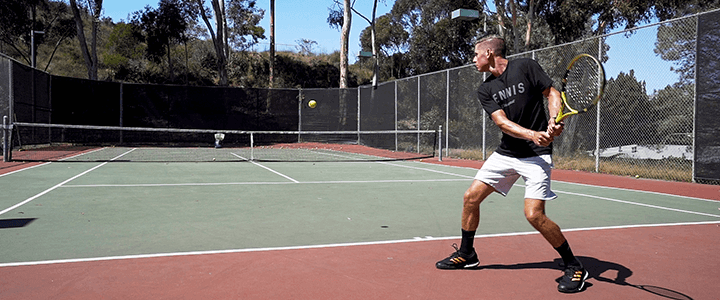
If I had to pick one area where Babolat Pure Aero shines and comes to life, hands down, it would be groundstrokes.
Whether I was hitting forehands or backhands, I love the racquet’s crisp feel, generous sweet spot, and the satisfying pop you hear when striking the ball thanks to Baboat’s Coretext Pure Feel positioned at three and nine o’clock within the frame.
With its 4pt head light balance, the racquet swings fast, but it also has enough weight to maintain stability through contact.
Power comes relatively easily, but it’s not overbearing and aligns well with the topspin centric features of the frame, allowing me to swing fast with confidence that the ball will drop back into the court.
For players with a semi-western or western forehand grip, the result is a heavy ball that bites when it hits the court, especially when paired with a polyester string like Babolat’s RPM Blast.
If your game doesn’t rely as heavily on topspin or you make use of an eastern forehand grip, I wouldn’t be surprised if you found it somewhat challenging to keep your shots under control.
The racquet’s spin-friendly feature set is also apparent when hitting slice, which may take some getting used to as that extra spin can translate to balls that tend to sail a bit long, especially if you’re coming from a lower-powered racquet with a tighter string pattern.
Of course, if you’re attempting to flatten out the ball, then your accuracy has to be on point to prevent it from sailing long.
Volleys
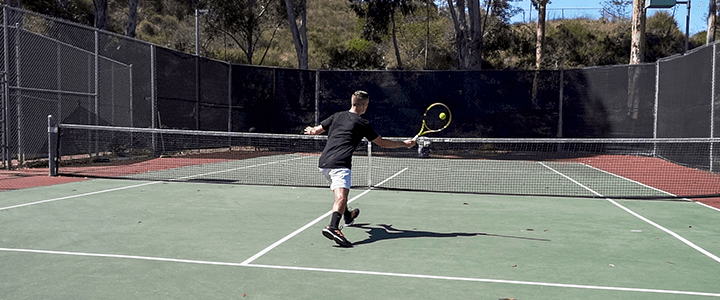
Up at the net, I found the Babolat Pure Aero to handle well with excellent maneuverability. At the same time, I’d consider volleys where the racquet offers its weakest performance, and you’ll find an incentive to get to the ball early.
If you’re connecting with a volley above the height of the net, the racquet can help deliver a firm and convincing putaway. However, the Pure Aero demands extra soft hands and gentle touch to prevent the ball from getting away from you and reign in the racquet’s power.
Although from the back of the court, I thought the racquet’s weight was sufficient, there were times where I’d prefer a bit extra in the upper hoop of the racquet’s head for volleys. A small tweak here would help absorb pace and improve stability, so that’s an area of customization you might want to experiment with to dial things in a bit.
To be clear, the Babolat Pure Aero isn’t a poor performer up at the net, but it’s also not the best, and as far as different shots go, not where the racquet shines. There’s just a bit of tradeoff you’re making here.
Serves

For serving, I thought the Babolat Pure Aero was excellent and where the power of the racquet is on full display.
On flat serves, the racquet has no problem delivering exceptional pace without trying too hard. Also, despite the Pure Aero’s spin-friendly setup, it’s easy enough to keep the ball flat for a penetrating serve.
When hitting slice serves, you get to take advantage of the racquet’s added spin potential, which makes for a great serve out wide, and an effective body serve to catch your opponent off balance.
However, my favorite type of serve when it comes to the Babolat Pure Aero is the kick serve and where I see the most pronounced difference.
During every kick serve, I could sense the grip of the strings on the ball, which helped with a high clearance over the net and subsequent dive and leap of the ball as it strikes the ground. The result is an increase in confidence and reliability on serve.
Although I enjoy the Pure Aero on serve, your arm will tend to pay for it if you miss the sweet spot. I noticed this on a few flat serves, and the resulting shock and vibration are immediately apparent.
Luckily, that’s not a regular occurrence, but it does shine a light on the frame’s overall lower comfort level, one of the most common complaints associated with this line of racquets.
Returns

Last but not least, when it comes to returns, the Babolat Pure Aero performs well. Everything I love about the racquet when hitting groundstrokes translated well to this stroke, and it has plenty of maneuverability to get the racquet back quickly.
The additional margin of error on my returns from the racquet’s added spin potential is a nice bonus, especially when stepping into a lighter second serve for a more commanding start to a point.
Although I think the racquet’s stability when fielding returns is stable, there are some cases where a bigger serve can cause the racquet to get pushed around a bit. With that in mind, some players might benefit from adding a small amount of weight to the frame.
Summary & Takeaways
Overall, the Babolat Pure Aero is an excellent frame that delivers controllable power and helps players maximize their spin potential.
It’s specs, including a 100 square inch head size, 16 x 19 string pattern, and manageable strung weight of 11.2oz or 318g also make the racquet approachable for a wide range of players and skill levels.
Here’s a look at some of the racquet’s upsides and downsides.
| Pure Aero Models |
| Babolat Pure Aero |
| Babolat Pure Aero Plus |
| Babolat Pure Aero Team |
| Babolat Pure Aero Lite |
| Babolat Pure Aero Tour |
| Babolat Pure Aero VS |
Upsides
- Topspin
- Power
- Control*
*There’s a caveat here. Depending on the type of grip you use and your style of play, there are likely to be differing opinions.
I use a semi-western forehand grip and play with lots of topspin and find the combination delivers plenty of control, but that won’t be true for everyone.
Downsides
- Comfort
- Touch
Strings
There’s no doubt that the Babolat Pure Aero performs best with a lower power spin-friendly polyester string like RPM Blast, and the type of string I’d recommend for use with this racquet.
If you like what the racquet has to offer, but you’re looking for a slightly more gentle string setup, then a polyester and multifilament hybrid is a nice combination – I’d recommend the poly in the mains for durability and to maintain that strings characteristics as a priority.
On the note of durability, you should expect to require regular restringing of the Babolat Pure Aero for two reasons.

First, the racquets design characteristics that enable more significant string movement will lead to increased sawing of the strings and, subsequently, more string breaks. I strung at 16 gauge, and wear comes quickly, so players may need to consider bumping up to a lower string guage if that becomes problematic.
Second, even if you don’t break your strings, if you’re playing with polyester, you’ll want to keep your strings fresh to avoid the harsher feel that can start to materialize in this frame with a dead set of polys.
Bottom Line
If you prefer to hang out on the baseline and trade heavy groundstrokes, but still demand reliable performance from other areas of the court, then the Babolat Pure Aero is an excellent option.
However, if you don’t rely on heavy topspin or you’re an all-court player that spends as much time up as net as you do at the baseline, you may want to look elsewhere.
If you suffer from ongoing discomfort in your arm or have experienced tennis elbow in the past and that’s a concern, then I’d avoid this racquet. I haven’t experienced any issues, but it’s worth considering.
Wrapping Up
Hopefully, you found my review and playtest of the Babolat Pure Are to further your understanding of how the racquet performs and the type of player that would be an ideal fit.
Although I recognize it’s not always possible, I’d encourage players to demo the racquet and form their own opinions with my experience as a point of context for things to consider and keep in mind.
If you have any questions or you’d like to share your experience with the Babolat Pure Aero, please feel free to drop a comment below.
Play Better Tennis
Improve your game alongside our community of tennis players
Why join?
Discussion Boards
Join the conversation with other members of the community.
5 Point Friday
Read our weekly recap of the 5 most interesting things we dig up in tennis.

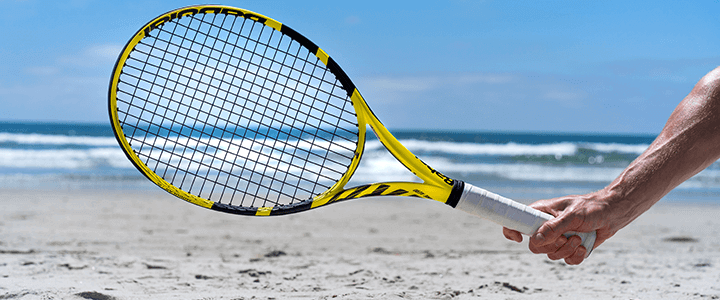

Leave a Reply
Want to join the discussion?Feel free to contribute!